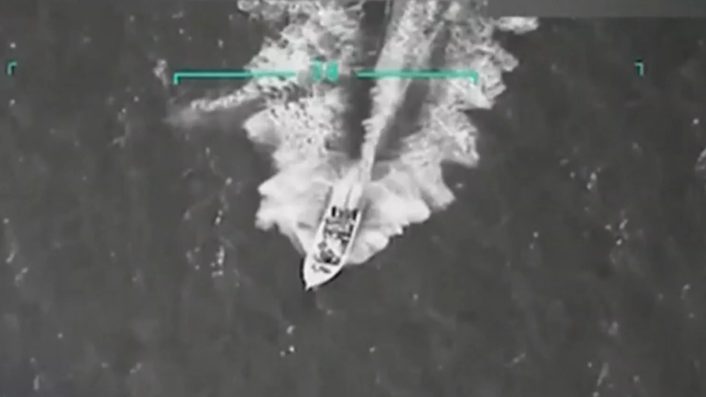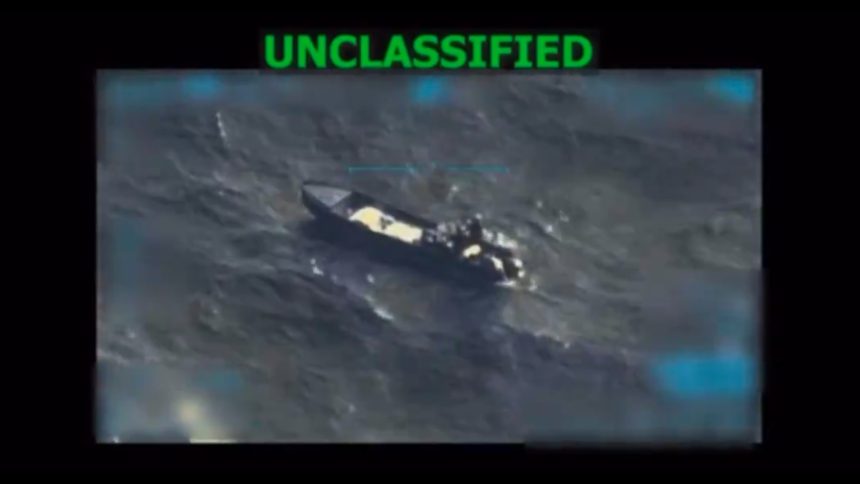President Trump announced the second lethal strike by the U.S. military as part of the counter-drugs operations.
This is a developing news, we will update it once new details are available.
U.S. President Donald Trump announced a new lethal strike against an alleged smuggling boat in international waters in the Caribbean. Once again, the boat was said to be used by Venezuelan cartels and resulted in the death of the three people on board.
Sharing the video on social media, the President said the people on board were “positively identified, extraordinarily violent drug trafficking cartels and narcoterrorists.” He also warned traffickers, saying that whoever is transporting drugs bound to the U.S. will be hunted.
The boat appeared to be still on the water, with personnel moving around. Few seconds later it was engulfed in flames, with the visual alternating between infrared and color cameras.
No details on the platform used to deliver the attack or the type of weapons employed were released. However, the circumstances of the attack appear to match the ones of the first attack on Sep. 2, 2025.
. @POTUS “This morning, on my Orders, U.S. Military Forces conducted a SECOND Kinetic Strike against positively identified, extraordinarily violent drug trafficking cartels and narcoterrorists in the SOUTHCOM area of responsibility. The Strike occurred while these confirmed… pic.twitter.com/KQYiEpqsGb
— DOW Rapid Response (@DOWResponse) September 15, 2025
The weapon involved could be an AGM-114 Hellfire missile, although this can’t be confirmed. Multiple platforms deployed to the area can employ the missile, which was also seen installed on U.S. MQ-9 Reapers deployed to Puerto Rico.
Context: the Strike that Changed Posture
The new strikes comes shortly after the deployment of F-35B Lightning II stealth fighters to Puerto Rico, which landed at Roosevelt Roads naval complex in Ceiba. The jets joined a broader and visibly expanded U.S. military posture in the Caribbean that U.S. officials tie to counter-drug operations.
The news about the F-35’s deployment was first publicized on Sept. 5, 2025, as a consequence of the flight of two Venezuelan F-16s near a U.S. vessel. Hours after the announcement, Venezuelan jets flew a second time over a U.S. warship, identified as the USS Jason Dunham, which was reportedly the same which experienced the interaction with Venezuelan F-16s the day earlier.
The overflights themselves were a consequence of the lethal strike against a suspected Venezuelan drug vessel in the southern Caribbean, carried out by the U.S. military on Sep. 2, 2025. This was the first known use of direct military force against a drug cartel’s maritime operations since the deployment of additional U.S. warships to the region.

As we reported, the strike provoked questions about legality and proportionality, withs legal and human-rights concerns raised by scholars and some members of Congress, who questioned whether lethal force in international waters was consistent with international law and traditional interdiction practice. Critics also point out the unusual nature of using high-end airpower for maritime drug interdiction when law enforcement boarding and seizure have historically been the norm.
Regional signal and escalation risk
U.S. officials frame the deployments primarily as counter-narcotics operations designed to disrupt maritime trafficking and protect U.S. forces and vessels operating in international waters. Nevertheless, the scale and visibility of the buildup—a mix of surface combatants, submarine assets, thousands of Marines and new airpower—have been interpreted by some observers as a broader signal to Caracas.
Caracas has accused Washington of using counter-narcotics as a pretext for pressure or regime change. The latter maintains that the goal of the operation is to stop the downpour of drugs in the U.S. cities, although the Trump administration has also doubled its bounty on Venezuelan President Nicolás Maduro to $50 million, accusing him of supporting drug trafficking and criminal networks, according to Reuters and CNN.
That environment, however, elevates the risk calculus, as there is the potential for miscalculation during close maneuvers at sea and the political sensitivity of strikes or shoot-downs. President Trump’s public comments warning that Venezuelan aircraft could be shot down if they placed U.S. ships “in a dangerous position” signal that the situation might become tense at any point in future if events are misjudged.









